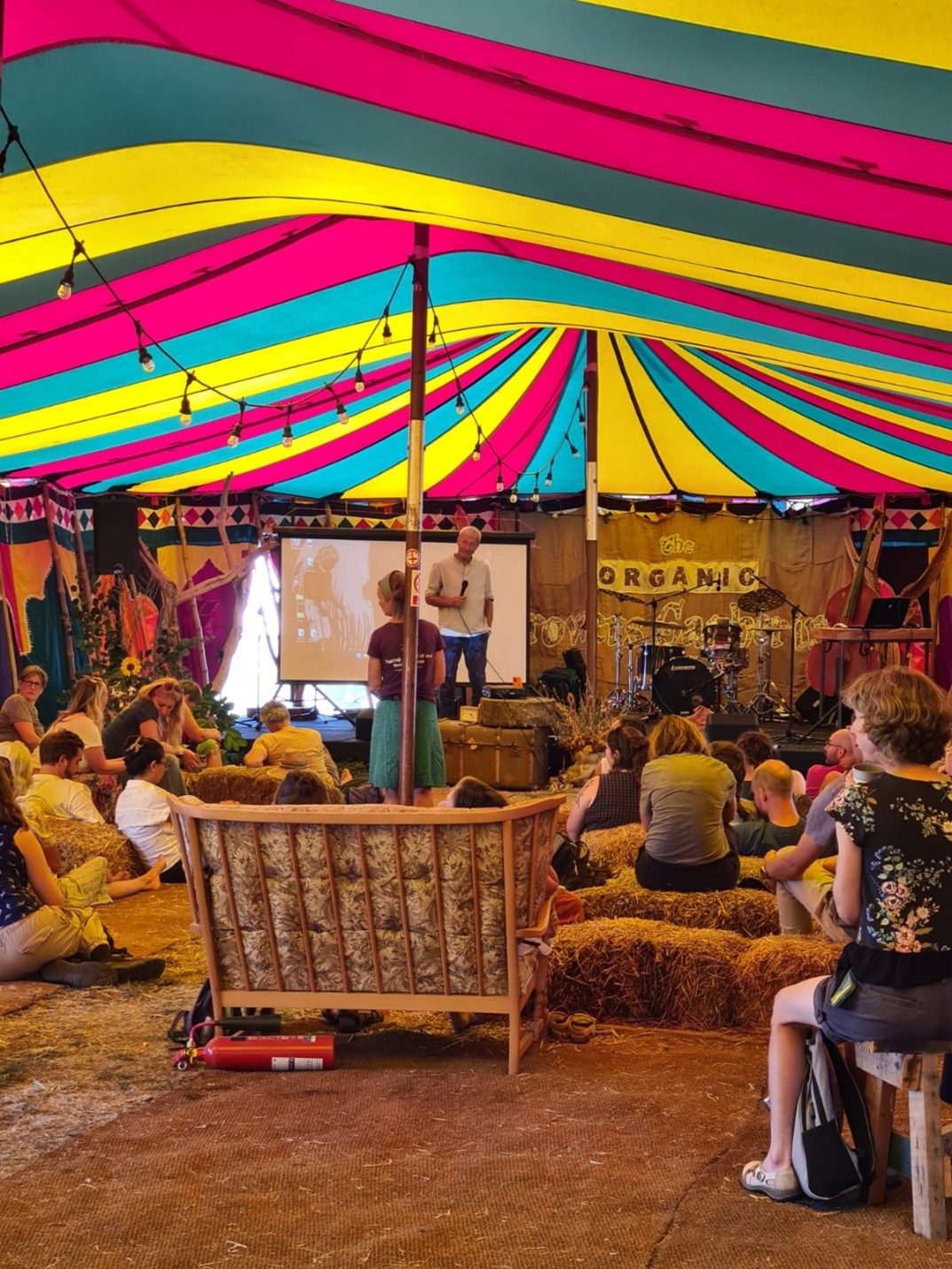SFC’s Community Growing Development Worker Sophie Bailey attended The Organic Growers Gathering over the sunny August bank holiday weekend. It is a small gathering set within the Hardwick estate in Oxfordshire, home to Tolhurst Organics – one of the oldest organic farms in the country.
Tolhurst Organics is a stock-free organic market garden and field scale farm covering 17 acres. The surrounding Hardwick estate covers 900 acres with 300 dedicated to organic arable and pasture. It also boasts woodland, borders the river Thames, and is undergoing transition to become the first community-led estate.
The event took place from Friday to Sunday, with three full days of talks and workshops led by a wide range of speakers from across the country. Topics included biodynamics, no dig, community ownership, homeopathy, cut flowers, seed saving, plant propagation, agroforestry, CSA models and much, much more!
Among the more well-known speakers were Kate McEvoy of Real Seeds, Guy Watson Singh of Riverford Organics, and Charles Dowding, advocates of the No Dig method.
Weekend Highlights
While there are too many great sessions to list, here are three talks that particularly stood out:
- Farm tour – Tolhurst Organics
Maria Jenkins, head grower at Tolhurst Organics led a captivating tour through their incredible walled garden, glasshouses and polytunnels. They have a mix of tilled and no-dig beds. Their tool shed alone was impressive, lined with vintage tools still very much in use.
Tolhurst also grows at field scale and they actively nurture their soil to balance the impacts of using machinery. They operate their beds on a seven-year rotation; two years of rest and green manure followed by five years of food production. They produce all their own seed compost from wood chip and are renowned for their high yielding Strawberry crops which helps bridge the hungry gap sales.


- Growing more seeds in your market garden – Kate McEvoy, Real Seeds
Kate delivered an enthusiastic talk on the benefits of seed saving. She emphasised how growing your own seed can save money, improve germination and help adapt to changing climates. Whilst commercial seed suppliers may offer drought or wet tolerant seeds, home seed saving allows growers to cultivate varieties adapted to both, and their local micro-climate.
Kate recommended starting with easy-to-save seeds such as tomatoes, peppers, peas and rocket. Real Seeds provide information practical seed-saving guidance with all seeds sold. Garden Organics also have a heritage seed library and freely accessible seed saving information. As do The Gaia foundation with great resources and training available for commercial, community groups and home gardeners alike.
- CSAs and Growing for Community
This session featured three different speakers, each presenting their unique CSA model. It was very interesting to hear how farms approach membership, sales, and community involvement.
- Canalside Community Food operates a community benefit society. Members invest in shares and receive a 2% annual return. The farm provides 140 boxes per week from a 10 acre site. They don’t accept ‘pauses’ to memberships, instead encouraging members to donate their share whilst away. They aim to produce all their own veg box produce, but highlighted that with an increasingly unpredictable climate, they are experiencing the need to buy more in.
- Yorkshire Edible Flowers in Doncaster provides 40 shares a week and donates an additional 15 to local food banks. They also have 5 shares dedicated to social prescribing, shares for people managing high blood pressure or diabetes. They host inclusive community days, designed so that anyone can participate – no outdoor gear required. They also run an edible and cut flower business which supports the CSA. They upsell by allowing customers to add veg or flowers to their cart, boosting conveinece for customers and sales.
- Chagfood, based in Dartmoor supplies 25 shares from a 1 acre site. They adhere closely to more ‘original’ CSA principles. They don’t allow members to ‘holiday’ from their share and place a strong emphasis on the shared risks and seasonal eating. This model means they have a steady income throughout the year, and means that during the busy summer season they don’t have to worry about attending farmers markets to make up shortfall for their produce.
Final thoughts
I learnt so much over the weekend felt inspired by the community of like-minded individuals all working towards the same goals, growing nutritious food, engaging local communities, and nurturing the land with care.
An unexpected highlight was the communal meal-times – with large shared tables where speakers, volunteers, and attendees mingled freely. These moments created opportunities for spontaneous networking and space for discussions to continue after talks and workshops.
If you’re interested in learning about the gathering, or would like to watch some of their recorded talks, including the CSA and Seed talk mentioned, you can visit their website.

